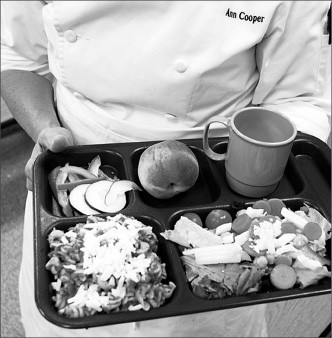
Ah, the school cafeteria. Land of tater tots, mystery meat, and
cranky lunch ladies. Long the source of material for TV shows, movies,
and comedy acts, school cafeterias are in reality no laughing matter.
Nearly 27 million children eat meals at school every day, and for most
of them, what they eat at school is the most nutritious meal of their
day. The problem is, it can’t even be called nutritious.
“Look at what our children are being offered at school: processed
foods high in fat, junk food, soft drinks loaded with sugar … the
list goes on,” says Chef Ann Cooper, school-lunch-reform advocate and
author of Lunch Lessons: Changing the Way We Feed Our Children.
“It’s a public-health time bomb.”
According to the Centers for Disease Control, the prevalence of
obesity among children 6 to 11 years has more than doubled in the past
20 years. Among adolescents, obesity has more than tripled. Sixty
percent of children and adolescents exceed the USDA daily dietary
guidelines for saturated fat, and only 40 percent meet USDA daily
requirements for fiber.
“Kids are bombarded with Happy Meal commercials that tell them that
they have to eat McDonald’s food to really be happy,” says Vaughan
Dewar, founder of Food Awareness, a Memphis-based volunteer group
devoted to raising awareness about the benefits of a plant-based
diet.
Parents should be ultimately responsible for what their children
eat, but schools have a great opportunity, and responsibility, to
contribute to the health of the nation’s children. Seventy percent of
all elementary schools meet government-mandated nutritional guidelines,
but only 20 percent of secondary schools do.
“Whatever we’ve been doing is not working,” Dewar says. “We’ve
obviously got a problem. One of the best ways we can address the issues
is to improve the school lunch program.”
Cooper, who is the director of nutrition services in Boulder,
Colorado, has been involved in the culinary world for more than 30
years and has been a school lunch reformer for more than a decade. She
is partnering with organic food leader Whole Foods Market to raise
funds to continue building “The Lunch Box,” a free online resource to
empower schools to reform their lunch programs.
In an effort to give students healthier meals, Cooper encourages
schools to serve more fruits and vegetables, buy from local farmers,
and involve the kids in the process of growing and preparing food. She
also speaks at town halls and PTA meetings and reaches out to
communities with tools like calendars with menus and recipes.
“We are marketing to parents, who really care about the issues,”
Cooper says. “We are marketing to the advocates, and of course, we are
marketing to the school administration.”
Any change will have to be incremental. “We should work toward
replacing the most harmful foods first,” Dewar says. After he made a
presentation to Memphis City School leaders about the dangers of eating
processed meats, he began working with them to find substitutions for
items like hot dogs. So far, he hasn’t had any luck. “My challenge is
trying to find a substitute that can compete with a 20-cent hot dog,
bun, and ketchup,” he says.
In order to replace harmful foods, three criteria have to be met: It
has to be cost-effective, it has to meet nutritional guidelines, and,
perhaps most importantly, it has to pass the student taste test.
As any parent can confirm, getting kids excited about healthier food
can be a challenge. Cooper says the key is hands-on experience.
“Kids should be gardening, cooking, touching the food, planting the
food,” she says. “We send interns into school cafeterias and have them
do tastings with the kids.”
In addition, changes in the cafeteria have to be within the
constraints of available equipment and personnel. “When you have lunch
ladies who are used to working with box cutters and scissors, you have
to retrain them to be more actively involved in the food preparation,”
Cooper says. According to Dewar, most school cafeterias simply heat up
frozen, pre-cooked food to serve to students.
Cooper argues that school lunch reform is possible without pouring
tons of additional money into the school system, but she does admit
that more funding will be necessary in the future.
“The issue is not about spending less — or even about spending
more,” Cooper states in her book. “We need a different worldview based
on measuring the health of children and the health of the planet.”